As digital projection saturates the world’s cinema markets, quality and cost will compete.
MICHAEL EISENSTEIN, SCIENCE WRITER
Over the past 40 years, audiences have grown accustomed to seeing lasers used on screen in blockbuster action and science fiction films. More recently, lasers have carved out an essential role behind the scenes as well, enabling cutting-edge digital projectors that can deliver brighter images with richer color and more consistent quality over time.
Digital projectors first reached theaters in 1999, with a push from George Lucas and 20th Century Fox, who wanted to use the technology to showcase the first of the modern generation of “Star Wars” films, “The Phantom Menace.” Since then, the technology has all but supplanted conventional mechanical film projection. By the end of 2017, the Motion Picture Association of America reported that 98% of the world’s cinema screens used digital projection.
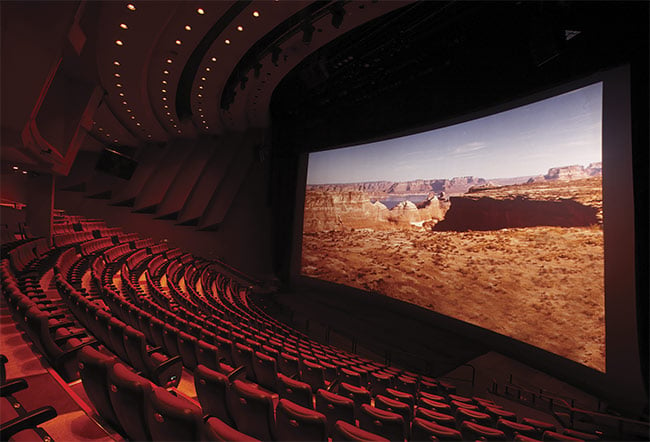
An IMAX theater in Seoul, South Korea, outfitted with a Barco laser projector. Courtesy of Barco.
The first wave of digital projectors used xenon lamps for illumination, like the conventional projectors that preceded them. However, instead of illuminating film, the light source is beamed onto a vast array of tiny, individually controlled micromirrors that modulate the light to produce a digital image.
These projectors deliver image quality that outperforms older projectors in many ways, but they also require frequent lamp replacement and can achieve only limited brightness. Projectors that instead rely on laser-based illumination overcome many of these problems, according to Rich McPherson, senior product manager at NEC Display Solutions of America Inc. “It has been proven that the color rendition is fantastic, the longevity’s there, and the overall image quality is going to make a bigger impact for audiences,” he said.
Many cinema owners were cautious about using laser-based technology when it first reached the market in 2013 with a relatively high price tag and no track record in the industry. “It’s one thing if it’s being used in a lab somewhere, but in cinemas, these things have got to live for a lot of hours over a lifetime with the same level of light and image quality,” said David Hancock, president of the European Digital Cinema Forum.
Accordingly, initial adoption occurred primarily in premium theaters where customers pay a surcharge for a top-quality experience. For 3D films, these projectors quite literally outshine the relatively dim projection achieved with xenon. But laser is finally entering the mainstream, and Susie Beiersdorf, vice president of cinema sales for Christie Digital Systems USA Inc., estimates that up to 10% of the world’s 200,000-plus screens now use laser projection.
Balancing beams
There are two major categories of laser projectors. In RGB laser projector systems, the three primary colors are each generated by separate red, green, and blue lasers. In their earliest iterations, the lasers were housed outside the projector itself, with the light being directed into the system through optical fibers. This design enabled cinemas to house the noisy cooling systems that supported these early lasers outside of the theater but also created ample opportunities for light loss by the time the lasers reached the micromirror array. To address this, the new generation of RGB systems uses solid-state diode lasers that can be housed within the projector itself.
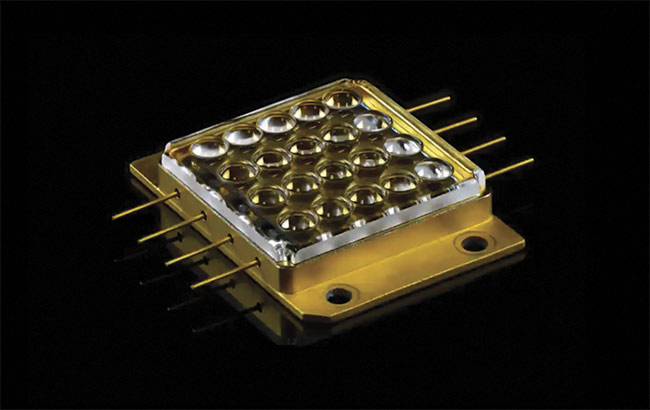
One of the multilaser pack devices used in Christie’s RGB laser projector systems. Courtesy of Christie Digital Systems
Manufacturers have also developed an alternative projector design that reduces costs by using fewer and less expensive lasers. Such systems typically incorporate a pair of blue lasers, where one laser is directly used to generate the blue primary color, while the other is used to illuminate a phosphor wheel that absorbs the blue wavelengths and emits light that can subsequently be filtered to produce the red and green primaries needed to complete the image. Alternate versions of this laser phosphor design use red and blue lasers to generate primaries and rely on the phosphor wheel only to generate the green primary.
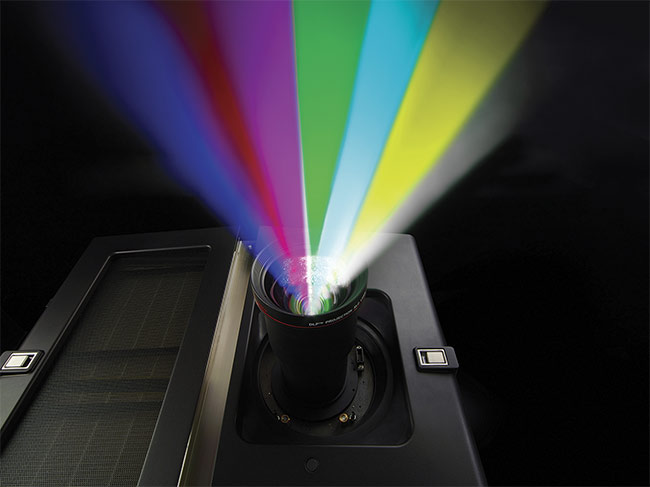
RGB laser projectors such as Barco’s DP4K-60L can capture much of the Rec. 2020 color gamut — a possible emerging standard for digital cinema. Courtesy of Barco.
Both systems can deliver bright, high-resolution video, and various laser projector companies have chosen different platforms as their flagship cinematic technology. For example, NEC focuses primarily on laser phosphor, Christie has prioritized the RGB laser, and digital projection and imaging technology company Barco Inc. is developing both laser projection systems in parallel. Laser phosphor was initially a lot more affordable. According to Tom Bert, senior product manager for digital cinema at Barco, in many cinematic settings these projectors can perform comparably to their RGB counterparts, but at a lower price point. “From an on-screen performance perspective, they are 99% the same,” Bert said. “And if you configure your cooling properly, you can get equal lifetime out of phosphor and RGB lasers.”
Currently, cinemas are expected to exhibit digital projections that achieve a specific color gamut established by the Digital Cinema Initiative (DCI), known as DCI-P3, and laser phosphor and RGB laser systems can both deliver DCI-P3. However, RGB systems also have the capacity to generate an even wider range of colors, spanning the much larger color gamut known as Rec. 2020. Whereas the DCI-P3 gamut spans an estimated 53.6% of the color spectrum visible to the human eye, Rec. 2020 covers 75.8%. RGB manufacturers see Rec. 2020 capability as an important asset if it becomes the new cinematic standard — although when and if this will happen remains uncertain.
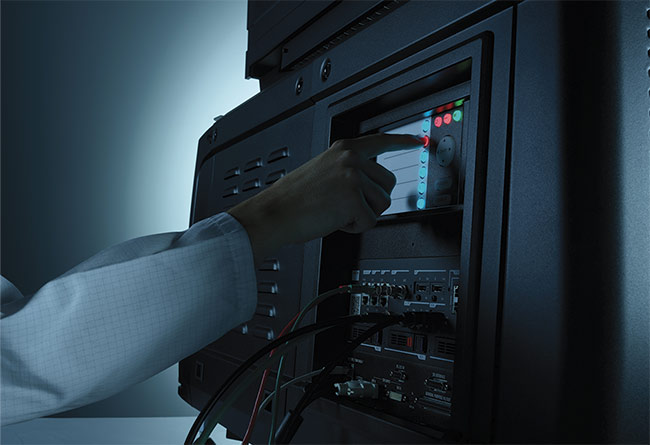
Streamlined interfaces and ease of operation are top priorities for companies creating the next generation of laser projectors. Courtesy of Barco.
RGB systems do offer a more decisive advantage in terms of brightness, with current systems achieving peak performance of more than 60,000 lumens versus the laser phosphor systems, which currently deliver between 30,000 and 40,000 lumens. This differential will not be meaningful to viewers in a typical theater setting, but on larger screens — and particularly in the context of 3D — this extra brightness becomes more important. “That’s probably why RGB has taken off on the premium cinema side,” Hancock said.
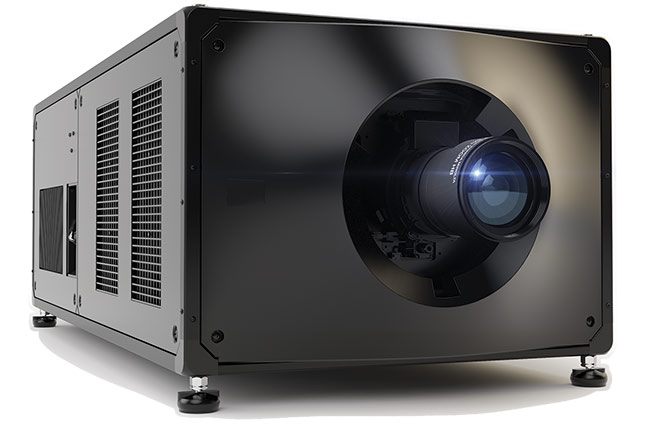
The latest generation of RGB projectors from Christie can present 4K resolution at a rate of 120 fps. Courtesy of Christie Digital Systems.
The cost differential is also shrinking
quickly. According to Hancock, the first-generation RGB systems could cost as much as a quarter of a million dollars, but today, projectors are available for less than $100,000. The recent availability of high-quality green lasers has been a contributing factor to this markdown. “In 2014 or ’15, these did not exist,” Bert said. “So if you wanted to make green laser light, you had to start with infrared light and double the frequency, which was a bulky and complicated technological process.”
Cutting costs
Cinemas are expected to exhibit digital projections that achieve a specific color gamut established by the Digital Cinema Initiative.
Purely in terms of projector cost, xenon lamp systems remain the cheaper option, but when focusing on the total cost of ownership, the playing field becomes more level. “There’s none of the maintenance associated with changing bulbs [with laser systems],” Hancock said, “and there’s electricity savings as well.” For both phosphor and RGB systems, the life expectancy of a laser run at maximum brightness is on the order of 20,000 to 30,000 hours, at which point the brightness is sufficiently reduced to require replacement. But according to McPherson, exhibitors have some flexibility in terms of operating conditions, which can lead to longer life expectancy.
Lasers’ superior brightness relative to xenon-lamp projection also makes them an excellent fit for 3D films, where dim and murky images have long been a complaint for moviegoers. For example, DCI standards currently specify that 2D films should be shown with a brightness of 14 footlamberts, but xenon-lamp projectors that meet this specification will only be able to deliver 4.5 footlamberts for a 3D film. In contrast, laser projectors can deliver much higher brightness while maintaining a stable, flicker-free image. Some manufacturers have developed RGB laser systems specifically optimized for 3D films — so-called 6P projectors in which the lasers are tuned to produce each primary color at two different wavelengths.
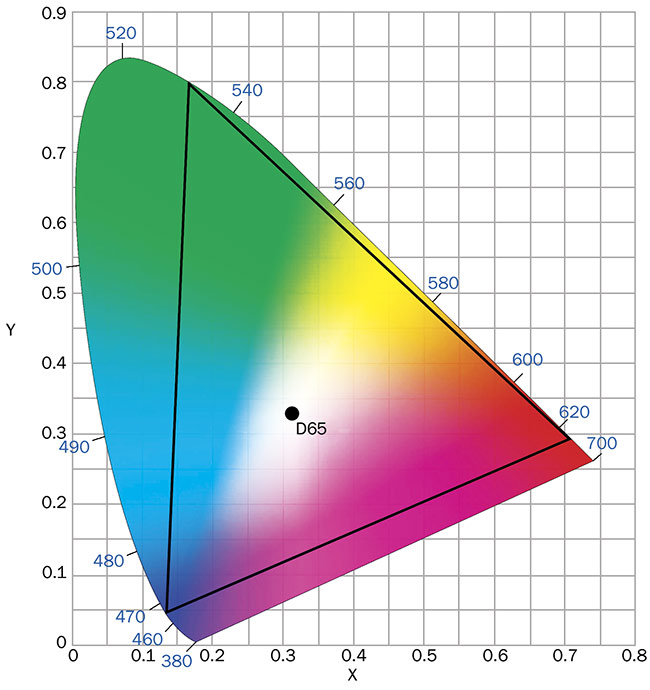
The Rec. 2020 color gamut relative to the visible spectrum. Courtesy of Sakurambo, Grand Drake/CC BY 3.0.
Although the 3D cinema market was a strong driver for laser projector adoption in the early days, demand for 3D films has waned considerably. According to Hancock, customers are increasingly less inclined to pay a surcharge to experience the latest blockbusters in 3D, and he suggested that this is a problem that even technological improvements cannot fix. Bert said he has observed the same phenomenon and that Barco has responded by shifting away from 6P RGB and back to the conventional three-primary projectors. “Ten years ago, they foresaw one in two screens to be 3D-capable, but what we have now is closer to one in three or one in four screens,” he said. “Going from six to three primaries reduces system complexity and cost, and so it’s a perfect solution for the mainstream.”
Future focus
Laser projector systems have overcome most of their early growing pains. And indeed, one may even wonder how many realms remain for laser projectors to conquer, other than cost. For example, if cinema standards end up making the leap from DCI-P3 to Rec. 2020, the benefits of further expansion of the color space are questionable.
Contrast and dynamic range are
among the few remaining visual battlegrounds for this technology. According
to Beiersdorf, this has been a major priority at Christie. “With Dolby, we’ve developed a high-dynamic-range system with a million-to-one contrast ratio and higher brightness,” she said. This higher brightness could produce an unpleasant strobing effect at the standard frame rate of 24 fps, but Christie’s system overcomes this by presenting the film at an unprecedented 120 fps. The company chose the release of Ang Lee’s new film, “Gemini Man,” in October as an opportunity to showcase the new technology.
Otherwise, manufacturers’ top priorities are advancements targeted at satisfying exhibitors rather than wowing audiences. For example, NEC’s new projectors will make it easy to swap out dying laser sources on-site, rather than having to go back to the company for a replacement. Automation is also a top priority, so that exhibitors can keep the show going with minimal intervention or oversight. “It’s not the kind of thing I like to hear as a product manager. I want them to say it’s such a sexy product they want to use [it] every hour of the day,” said Bert. “But what they want is to install the projector on day one and never have to be back in that room again for 10 years.”
Acknowledgments
The author would like to thank David Hancock of the European Digital Cinema Forum, Susie Beiersdorf of Christie Digital Systems, Rich McPherson of NEC Display Solutions, and Tom Bert of Barco.